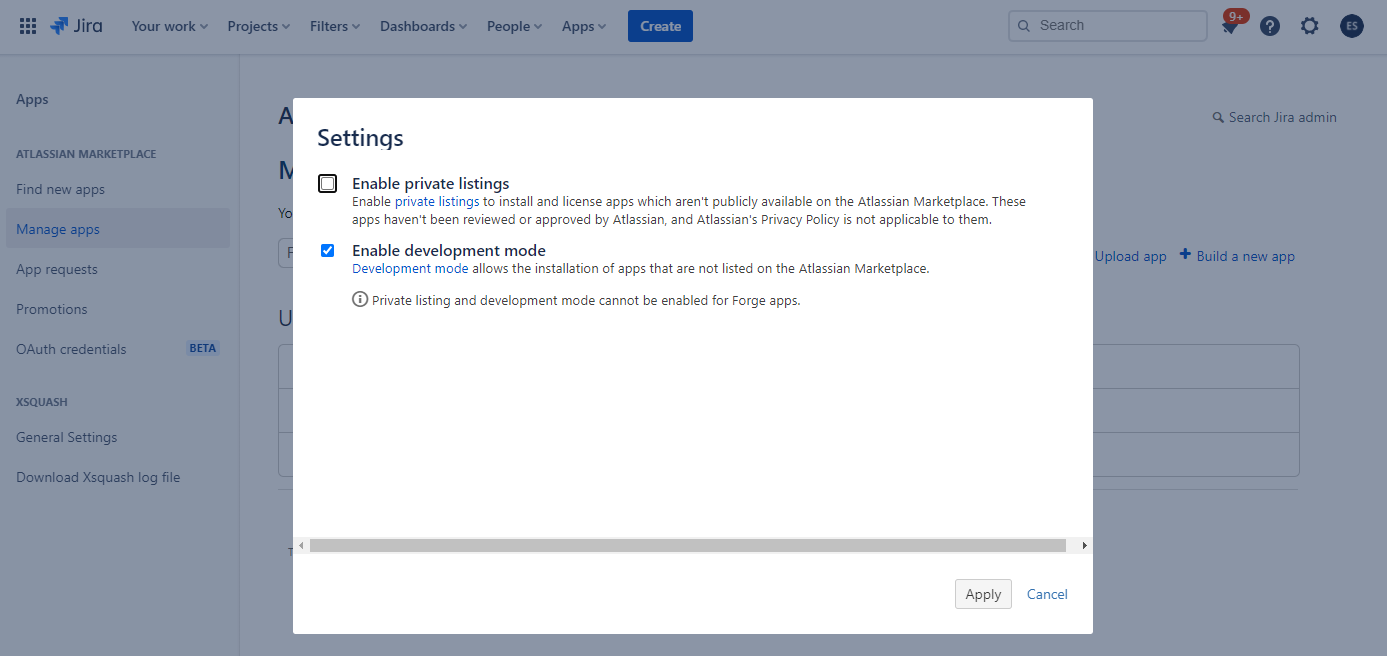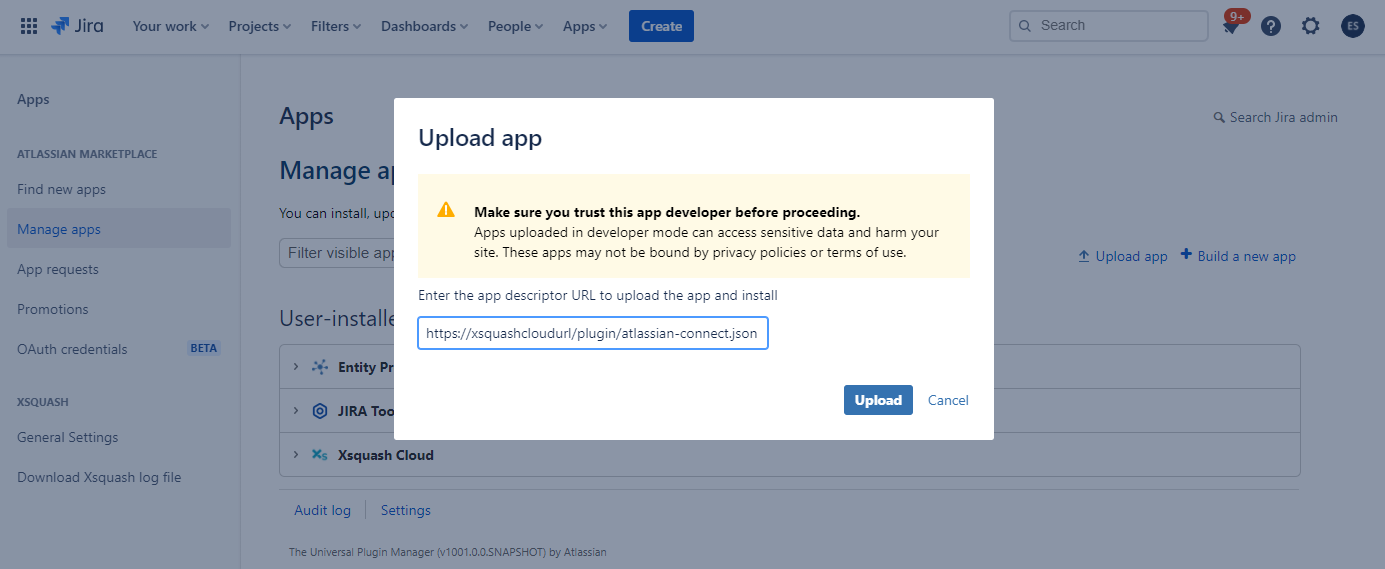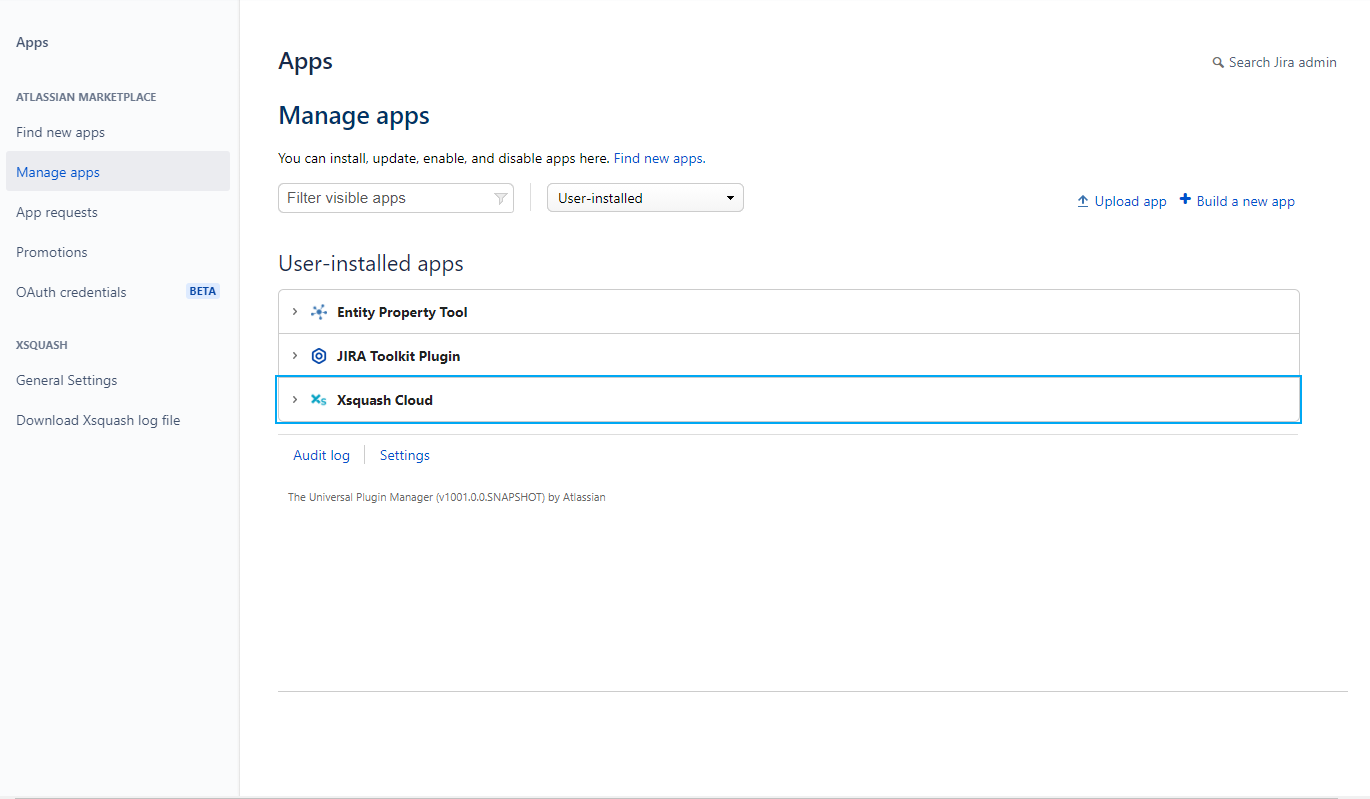Install Squash TM License and Plugins
Install Squash TM Plugins
To install plugins in Squash TM, you must follow this procedure for every OS:
- Download the plugin from the site https://www.squashtest.com or from the links provided to you by the Squash Support Team
- Extract the plugin
- Select all the .jar files it contains and put them in the following folder:
- /opt/squash-tm/plugins : for Linux tarball
- C:\
\squash-tm\plugins : for Windows
- In Linux, give read permission to the Squash TM user for the .jar files
- If it is a commercial plugin, make sure that the license file 'squash-tm.lic' is in the folder 'license'
- Restart Squash TM for the plugins installation to be taken into account
Info
The list of installed plugins can be directly viewed in Squash TM by a functional administrator in the system information.
Once installed, some plugins can operate right away, such as API, reporting plugins, or the Actions Library plugin. Other plugins need to be configured in the server or in Squash TM administration workspace.
Learn More
To learn more about configuring plugins in the server, please read Configuring plugins. For other configurations, please read the Administrator Guide.
Install the Commercial License
The use of Squash TM commercial plugins is determined by the presence of a license file: squash-tm.lic. This file is mandatory to start Squash TM with commercial plugins.
This file is given to the client by the Squash Support Team following the formalization of a new license or a renewal.
This license file is unique to each client. It contains the following information: - expiration date - number of users - list of the authorized commercial plugins according to the license(s) you have
You can use this license file for production instances as well as preproduction instances.
To install the license file in Squash TM:
- In Squash TM's "plugins" directory, create a sub-directory entitled 'license'
- Put the file 'squash-tm.lic' given to you by the Squash Support Team in that sub-directory
- Restart Squash TM
The license file controls the number of active users in Squash TM. When the maximum number of users is exceeded, a message appears to alert the administrators. If this number is exceeded by more than 20%, the creation of new users is blocked.
Two months before the license's expiration date, a message alerts the administrators. Beyond this date, the message will alert all the users. If the license is still not renewed two months after the expiration date, Squash TM shuts off. You will then have to uninstall the commercial plugins to be able to restart Squash TM.
Install Xsquash for Jira Server
Xsquash is an additional component available on the Atlassian Marketplace for Jira Server and Jira Data Center that reinforces the integration between Squash TM and Jira. It displays Squash TM test cases and executions directly in Jira issues that were synced in Squash TM via Xsquash4jira.
Info
The data is displayed in Jira via Squash TM's REST API. This plugin does not write in the Jira database.
To install this plugin, you must have at least these prerequisites:
- Jira Server or Data Center 8+
- Squash TM version 1.19.0+
- Squash REST API 1.1.0+
- Xsquash4Jira 1.2.0+: Xsquash4Jira plugin must be installed in Squash TM and be set up for at least one project
Learn more
For more information on how to configure the Xsquash4Jira plugin, please visit this page Configure Xsquash4jira in Squash TM
To install the Xsquash plugin on Jira Server or Jira Data Center, please follow these steps:
- Log into Jira as an administrator
- Go to "Jira Administration" and click on "Manage Apps". The Atlassian Marketplace for Jira appears
- Search for Xsquash in the Marketplace. The search results include the app versions that are compatible with Jira
- Click on [Install] to download and install the app
- Click on Close in the dialog window
Xsquash must be configured for it to work.
Learn more
For more information on how to configurate the Xsquash plugin, please visit this page Configure Xsquash in Jira
Install the Xsquash Cloud app in Jira Cloud
Xsquash Cloud is an app hosted on an internal server of the company Henix. It reinforces the integration between Squash TM and Jira Cloud. It displays Squash TM test cases and executions directly in Jira issues that were synced in Squash TM via Xsquash4jira.
This app is only available if you have a commercial license.
Info
The data is displayed in Jira via Squash TM's REST API. This app does not write in Jira Cloud's database.
To install this plugin, you must have at least these prerequisites:
- Jira Cloud
- Squash TM version 1.19.0+
- Squash REST API 1.1.0+
- Xsquash4Jira 1.2.0+: The Xsquash4Jira plugin must be installed in Squash TM and be set up for at least one project.
Learn more
For more information on how to configure the Xsquash4Jira plugin, please visit this page Configure Xsquash4jira in Squash TM
There are two ways of installing the Xsquash Cloud app in Jira Cloud:
Install Xsquash Cloud manually
To install Xsquash Cloud manually, please follow these steps:
- Log into Jira Cloud as an administrator
- Click on
 . Choose 'Apps' then the option 'Manage apps'
. Choose 'Apps' then the option 'Manage apps' -
Click on 'Settings'. The 'Settings' window opens

-
Check the option 'Enable development mode' then click on [Apply]
- On the "Manage apps" page, click on 'Upload app'. The 'Upload app' window opens
-
Enter the URL given to you by the Squash Support Team then click on [Upload]

-
Xsquash Cloud appears in the list of installed apps.

Install Xsquash Cloud via the API
Before installing the Xsquash Cloud app in Jira Cloud via the API, you must have an administrator account with an API token.
To generate an API token, please follow these steps:
- Login with your administrator account. In "Your profile and settings", click on "Settings"
- Click on "Manage your account"
- Click on "Security"
- In the 'API Token' part, click on "Create and manage API tokens"
- Click on "Create an API token"
- Enter a description and click on "Create"
- Copy the token
Here are the steps to follow to install the Xsquash Cloud app via the API:
-
Make a GET request in BASIC AUTH to the following URL:
https://Jira-URL.atlassian.net/rest/plugins/1.0/?os_authType=basicwith the following info in the header:
Accept: application/vnd.atl.plugins.installed+jsonTo authenticate yourself, use the administrator's username and their API token
-
Recover the header "upm token" value in the answer
-
Make a POST request in BASIC AUTH to the following URL by replacing 'Upm-Token' by the value of the header "upm-token" you just recovered:
https://Jira-URL.atlassian.net/rest/plugins/1.0/?token=Upm-Tokenwith the following information in the header:
Content-type: application/vnd.atl.plugins.uri+json Accept: application/jsonand in the body the following command with the URL provided to you by the Squash Support Team:
{ "pluginUri": "https://Url-Xsquash-Cloud.com/atlassian-connect.json", "pluginName": "Xsquash Cloud" }To authenticate yourself, use the administrator's username and their API token
-
Xsquash Cloud then appears in the list of installed apps in Jira Cloud administration.
You must then configure the app in order to use it.
Learn more
For more information on how to configure the Xsquash Cloud app, please visit the page Configure Xsquash Cloud in Jira Cloud.